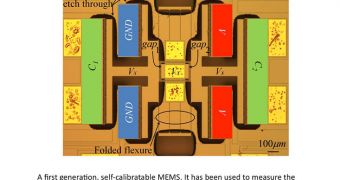Thanks to new advancements in science, producing micro electromechanical systems (MEMS) that have the ability to calibrate themselves is now possible. These nanoscale machines could in the future lead to the creation of extremely accurate sensors, to be used in a variety of applications.
The innovative devices could be employed for instance in environmental testing, for measuring traces of chemicals and pollutants in the atmosphere. They could also be used for increasing the accuracy of medical diagnostics, or for detecting hidden clues at crime scenes, as part of forensics investigators' kits.
The future “nose on a chip” could be employed in nanotechnology- and biotechnology-related studies, and could allow authorities to detect terrorists carrying forbidden substances a lot faster than currently possible. Solid or gaseous chemicals would be equally easy to detect.
“In the everyday macroscopic world, we can accurately measure distance and mass because we have well-known standards such as rulers or weights that we use to calibrate devices that measure distances or forces,” explains Purdue University assistant professor Jason Vaughn Clark.
“But for the micro- or nanoscopic worlds, there have been no standards and no practical ways for measuring very small distances or forces,” adds the expert, who teaches electrical and computer engineering, and mechanical engineering at the university.
Working with MEMS is however notoriously difficult. The components inside these systems are constructed at the micro- and nanoscale, which means that they are never exactly the same. At this level of miniaturization, even the slightest variation can change the way the entire MEMS functions.
“A 10 percent change in width can cause a 100 percent change in a microstructure's stiffness. Process variations have made it difficult for researchers to accurately predict the performance of MEMS,” Clark reveals. He is the developer of a new process that could eliminate discrepancies from this technology.
Called electro micro metrology (EMM), the new technique can be used to determine how a MEMS will move, or to establish what force is being applied to it. The amount of pressure that the device sense can also be calculated using EMM.
“For the first time, MEMS can now truly self-calibrate without any external references, That is, our MEMS are able to determine their unique mechanical performance properties. And in doing so, they become very accurate sensors or actuators,” Clark goes on to explain.
With the new generation of mechanical system, designing lab equipment could become easier than ever. Even atomic force microscopes (AFM) could be made to fit on a chip, Clark says. The new work was funded by the US National Science Foundation.

 14 DAY TRIAL //
14 DAY TRIAL //